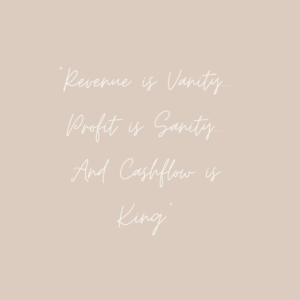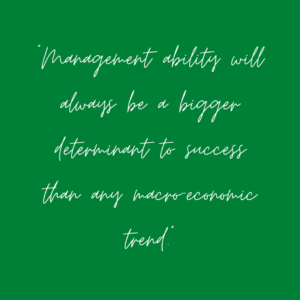Growing a business and growing net cash flow are two different things.

Looking for ways to generate more cash in your business? Around 10-20% of businesses consume cash as they grow. In other words, day-to-day trading always feels cash-strapped and aggressive growth involves constant juggling of finances & borrowing.
The less extreme cases can still be painful, as around 70% of businesses find that growth in revenue/profits is not matched by a proportionate growth in net cash.
As a result, you’ll find yourself working harder with more customers, more employees, more risk – but with no significant increase in your dividends.
Not much fun to be found in that.
It’s one thing to know and agree with the quote above. It’s another to know exactly what to do about it.
This is more complicated than ‘too many overheads’
Faced with this challenge, the natural response is to conclude that overheads are too high. But this is just one potential solution out of the 7 that are available to you.
The first step – as always – is to ‘frame’ the challenge clearly and accurately.
 There are 3 core challenges here:
There are 3 core challenges here:
- Firstly, understanding the ‘7 levers’ you have control over which actually determine the net cash flow
- Secondly, understanding which if they will have the biggest impact on net cash flow for your business
- And thirdly, measuring how effective (in hard cash) each of your actions has been
CHALLENGE #1: Understanding the 7 Levers to Control Net Cashflow
- Pricing: This is exactly as it sounds – how much you charge for your product or service
- Volume (Revenue): This is a function of new and repeat customers and how many products they buy – for how long and how often. Ie Marketing & Sales (plus Product Ladder and Customer Service)
- COGS (Cost of Goods Sold): These are your Variable Costs – the direct costs of providing your product or service. If you’re making stuff (say, furniture) the list will be long and heavy on £ – if you’re in a service industry (say, an architect) it’ll be short and light.
- Overheads: These are your Fixed Costs. In other words, what you pay whether you have any customers or not. If it’s on a recurring debit, it’s probably a fixed cost. This is where the majority of service-industry costs appear. Staff costs for revenue earners in a service industry are the equivalent of a physical product, they just appear under a different heading in your accounts.
- Accounts Receivable Days: This is the average number of days it takes to get paid. Which will be an important area if you’re paying out before you provide the product and then invoicing later.
- Inventory Days: This is a function of the amount of stock you hold and on average how long it takes to sell it. (For a service company this is WIP – Work in Progress).
- Accounts Payable: This is on average how long it takes you to pay your invoices.
And that’s it.
These are the only 7 Levers that you (the MD / CEO and your management team) can directly control to determine how effectively you convert revenue into cash.
CHALLENGE #2: Understanding which of the 7 Levers has the Biggest Impact on Net Cashflow for Your Business.
This is the most important of the 3 challenges.
If you know precisely what (in terms of hard cash) is up for grabs, you’ll have started down the road to fixing it.
I use a bespoke piece of software called ActionCASH to do this (created with the team at MyCashFlow Story).
It’s driven by 19 numbers from your P&L, Cashflow Statement & Balance Sheet and you’ll need a minimum of three periods to produce a compelling report – and ideally four. It takes in the region of 45 mins in total to set up – 15 mins each for you, your accountant and me.
45 mins in exchange for a degree of clarity on net cashflow that many listed companies don’t have.
Your profile will clearly isolate:
- The 7 levers for your business and the impact they have on net cashflow
- Your financial story in 4 chapters, covering P&L, Cashflow, Balance Sheet & Funding
- Your business valuation and how changes in the 7 Levers (and valuation multiples) impacts it
The Power of One
ActionCASH contains one of the most compelling and valuable financial modelling tools I have ever seen: The Power of One.
Clear, simple and easy to use, this allows you to play around with % increases and decreases in each of the 7 Levers, and ‘live model’ what happens to operate profits and more importantly net cashflow.
At a simple level, you might want to know:
- What happens to cash flow if we put our prices up by 1%, 2%, 3% etc?
- Is it more cash-effective to focus on volume or price?
- What happens to net cashflow if we get paid on average 3 days sooner?
- Or keep on average 3 days less stock?
At a slightly deeper level we could model:
- How many customers could we lose if we increased prices by eg 5% and still make the same operating profit or net cash flow?
- To what degree would getting paid sooner to reduce our borrowing requirements?
- What would happen to the valuation of the business if we increased prices or new customers by eg 5%?
This is a degree of insight that matches anything even the largest businesses have.
It will give you total clarity on where you need to devote your resources of people, time and money to get the biggest return.
It puts you in the driving seat of your business.
CHALLENGE #3: Measuring how effective (in hard cash) how each of your actions has been.
Ultimately, you’ll find the measure of success in your company bank accounts.
This is great, but of limited ongoing value as a management tool. Cash balances – even healthy ones – do not tell you how to go about building on those successes.
With this software you’ll be able to break this down and understand what has worked – and to what extent – and what hasn’t.
We can generate reports modelling different scenarios and outcomes, save each of them as a pdf and then use them to compare what happens with expectations & targets.
CONCLUSION:

The likelihood of a meaningful recession in Q3/4 2022 is now more of a probability than possibility. Consumer & business expenditure will be hit, putting additional pressure on your sales & marketing efforts to generate returns. In addition, this will make it harder to push through the price increases needed to protect your margins.
Whatever the future holds over the next 2-3 years as we deal with the consequences of the damage already done, it’s not going to plain sailing.
Which places a huge emphasis on the importance of knowing exactly – and I mean exactly – where to find the extra cash flow in your business and have a rock-solid strategy to get it.
As ever, we’re all in these storms together – but we’re not all in the same boat.
This could provide the visibility into your cashflow that makes all the difference.
WHAT HAPPENS NEXT?
If this has struck a chord, please share it. And I’d be glad to give you a complimentary guided tour by zoom.
Looking for a business coach in London, contact me here.



I was suggested this website by my
cousin. I am not sure whether this post is written by him
as no one else know such detailed about my problem.
You are incredible! Thanks!
Hi Kenneth – this was indeed all my own work and glad it added to your day! Best, Tim